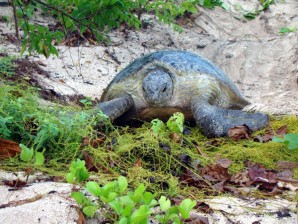Study of world’s richest marine area shows size matters

A sea turtle crawling back into the sea after laying eggs on Baguan Island, in Turtle Islands municipality. Photo by Orlando Maliwanag
GENEVA—A new study of Asia’s Coral Triangle, which contains nearly 30 percent of the world’s reefs, shows that when it comes to ensuring a rich and diverse range of species, size matters.
“The study suggests that marine protected areas should be as large and diverse as possible,” Peter Etnoyer, a marine biologist at the US National Oceanic and Atmospheric Administration (NOAA), said in a statement Thursday.
Etnoyer, who co-authored the study published by open access peer-reviewed scientific journal PLoS ONE, stressed that providing more protected marine space made it possible to “include more species, more habitats, and more genetic diversity to offer species the best chance of adapting to sea temperature and other environmental changes.”
The Coral Triangle covers a triangular area stretching across the Philippines, eastern Sabah, eastern Indonesia, East Timor, Papua New Guinea and the Solomon Islands.
It’s sheer size has made it a treasure trove of marine life — it contains nearly 30 percent of the world’s reefs and more than 3,000 species of fish and is often referred to as the “Amazon of the seas”.
The fact that its size, according to Thursday’s study, is also what will help it adapt to change is important, since previous reports have shown that more than 85 percent of the reefs there are considered to be threatened by human activities like coastal development, pollution and overfishing.
For the study, scientists at NOAA, the International Union for Conservation of Nature (IUCN), Old Dominion University in Virginia and the Harte Research Institute for Gulf of Mexico Studies had “analysed over 10,000 maps of marine species,” said Jonnell Sanciango, the head author of the study and a researcher at Old Dominion.
They had “found that habitat, calculated as coastline length, was the best predictor of species richness, followed by the variety of habitats and sea surface temperature,” she added.
Their research led them to suggest stretching the borders of the Coral Triangle further to also include Brunei, Singapore and peninsular Malaysia, “to ensure that these areas are included in the management and conservation of the region.”
The study also found that sea surface temperature plays an important role in the proliferation of marine life.
This suggests that “climate change may have a direct impact on species diversity,” the authors said in the statement.
“The conservation implication is that if climate change raises sea temperatures it may have a profound influence on evolution rates and how species are distributed over time,” Kent Carpenter of IUCN said.














